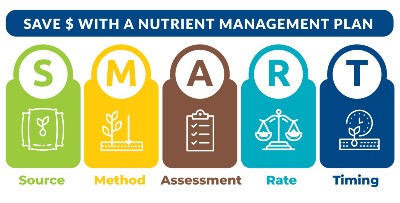Crops need nutrients to grow and thrive, but effective nutrient management is not one-size-fits-all. A nutrient management plan is specific to your land, the crops you grow, and many other factors that change over time. No matter the crops you produce or size of your operation, USDA can help you reduce input costs, maximize yields, and efficiently manage nutrients to support your bottom line and protect the environment.
On average, farmers can save nearly $30 per acre on land currently receiving excess nutrients by implementing a nutrient management plan.
SMART Nutrient Management
USDA’s Natural Resources Conservation Service (NRCS) works with farmers to develop nutrient management plans that optimize plant yields while reducing the amount of nutrients lost to the environment, where they can impact greenhouse gas emissions and air and water quality.
SMART Nutrient Management includes the 4Rs of nutrient stewardship – the right Source, right Method, right Rate, and right Timing – and emphasizes smart activities to reduce nutrient loss by Assessment of comprehensive, site-specific conditions.
A SMART Nutrient Management Plan considers all conditions on the farm and how they influence one another. It is tailored to the unique farm location, soil, climate, crops grown, management conditions, and other site-specific factors.
Below are the factors to consider when developing a SMART Nutrient Management Plan.

Get Help with a SMART Nutrient Management Plan for Your Land
NRCS offers voluntary programs and free one-on-one technical assistance to support a range of conservation goals, including nutrient management. Contact the NRCS office at your local USDA Service Center to get started with a nutrient management plan for utilizing and applying nutrients such as nitrogen (N), phosphorus (P), and potassium (K) on your cropland operation.
A local NRCS conservationist can help you evaluate your specific nutrient needs, assess your site-specific risks for nutrient and soil loss, and discuss opportunities to address those risks. This will result in a plan that includes details such as:
- Soil information – soil type, surface texture, drainage class, permeability, available water capacity, depth to water table, restrictive features, and flooding and ponding frequency.
- Available test results – for soil, water, compost, manure, organic by-product, and/or plant tissue sample analyses – to be leveraged in planning.
- Results of appropriate risk assessments for potential N, P, and erosion losses specific to your operation.
- Crop nutrient budget for the crop rotation, using your recent crop average yields.
- Science-based recommendations for the right source, application method, rate, and timing for all nutrient sources that are planned for use.
- Tips to support implementation and maintenance of your individual nutrient management plan.
Many of the tools for nutrient management planning don’t require a big investment. Using methods like soil and manure testing, in-season plant tissue testing, enhanced efficiency fertilizer products, and split application are examples of low-cost ways for managing nutrients more efficiently.
Learn More About Nutrient Management
Nutrient management is an important part of agriculture. Excess nutrients on the land can lead to nitrogen losses to the atmosphere. Nutrient management maximizes crop-nitrogen uptake and has a compelling and cost-effective role to play.
Visit farmers.gov/global-food-insecurity to learn more.
Additional Resources
- Farmers.gov Blog: Save Money and Protect Water Quality with SMART Nutrient Management
- Farmers.gov: Helping Farmers Address Global Food Insecurity
- Infographic: SMART Nutrient Management
- Fact Sheet: Estimated Potential Economic Benefits from Implementation of Practice 590 — Nutrient Management on Acres with Excessive Nutrient Loss
- Fact Sheet: SMART Nutrient Management — Save Money and Protect Water Quality
- USDA Report: Conservation Practices on Cultivated Cropland A Comparison of CEAP I and CEAP II Survey Data and Modeling
- NRCS: Technical Service Providers
Find Your Local Service Center
USDA Service Centers are locations where you can connect with Farm Service Agency, Natural Resources Conservation Service, or Rural Development employees for your business needs. Enter your state and county below to find your local service center and agency offices. If this locator does not work in your browser, please visit offices.usda.gov.
Learn more about our Urban Service Centers.
Visit the Risk Management Agency website to find a regional or compliance office or to find an insurance agent near you.
